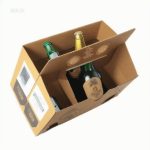
In the fiercely competitive beauty industry, where thousands of products vie for consumer attention, cosmetic packaging boxes serve as silent salespeople working tirelessly on shelves and in online stores. These beautifully crafted containers do more than just hold products—they tell stories, evoke emotions, and create lasting impressions. The production of cosmetic packaging has evolved from simple protective casing to an integral part of the brand experience, blending aesthetics with functionality in ways that can make or break a product’s success.
The journey of cosmetic packaging box production begins long before the first cardboard sheet is cut. It starts with understanding the brand’s identity, target audience, and market positioning. Luxury brands might opt for rigid boxes with magnetic closures and velvet finishes, while eco-conscious companies may choose recycled materials with minimalist designs. The production process requires careful consideration of materials, from traditional paperboard and corrugated cardboard to innovative biodegradable plastics and mushroom-based packaging. Each material choice communicates different values and appeals to specific consumer segments.
Modern cosmetic packaging production has embraced technological advancements that allow for unprecedented customization. Digital printing technologies enable brands to create vibrant, high-resolution graphics with Pantone color matching for brand consistency. Advanced die-cutting machines can produce intricate window designs, unique shapes, and structural innovations that make packages stand out. Embossing, debossing, foil stamping, and spot UV coating add tactile dimensions that elevate the unboxing experience from ordinary to extraordinary.
Sustainability has become a driving force in cosmetic packaging production, with consumers increasingly demanding environmentally responsible solutions. Production facilities now focus on reducing waste through efficient nesting of box patterns, using water-based inks and adhesives, and implementing recycling programs. Many manufacturers have developed innovative alternatives to traditional materials, such as boxes made from seed paper that can be planted, or packaging that incorporates post-consumer recycled content without compromising quality or aesthetics.
The functionality of cosmetic packaging boxes extends far beyond mere containment. Production must consider practical aspects like product protection during shipping, ease of assembly for manufacturers, and user convenience. Features like magnetic closures, ribbon pulls, and internal platforms not only enhance the user experience but also protect delicate products like pressed powders and glass bottles. Smart packaging incorporating QR codes and NFC technology bridges the physical and digital worlds, offering customers additional content, authenticity verification, and loyalty rewards.
Quality control in cosmetic packaging production involves rigorous testing for durability, structural integrity, and chemical compatibility with the products they contain. Packages must withstand various environmental conditions during storage and transportation while maintaining their visual appeal. Production facilities implement strict protocols to ensure consistency across large print runs, with automated inspection systems detecting even minor deviations in color, cutting, or finishing.
As the beauty industry continues to evolve, so too does cosmetic packaging production. The future points toward personalization at scale, with digital printing enabling cost-effective short runs of customized packaging. Smart packaging will become more sophisticated, potentially incorporating sensors that monitor product usage or freshness. The circular economy will drive innovation in reusable and refillable packaging systems, transforming how consumers interact with beauty products over their lifecycle.
Ultimately, cosmetic packaging box production represents the perfect marriage of art and science. It requires technical expertise in materials engineering and manufacturing processes, combined with creative vision and marketing intelligence. The boxes that emerge from this sophisticated production process do more than contain beauty products—they become part of the beauty experience itself, creating emotional connections that turn first-time buyers into loyal brand advocates. In an industry where perception is reality, investing in quality packaging production isn’t just an expense—it’s a strategic business decision that pays dividends in brand recognition and customer loyalty.




Leave a Message